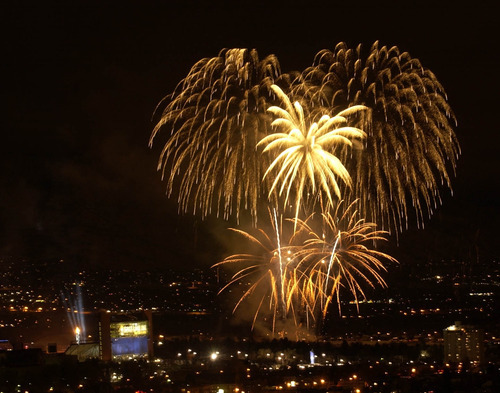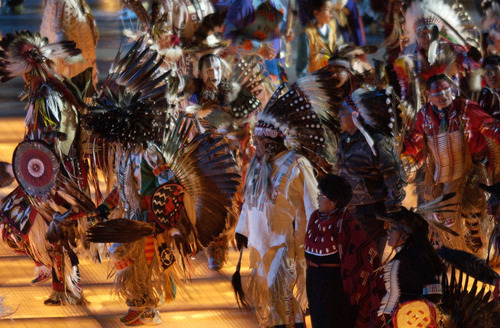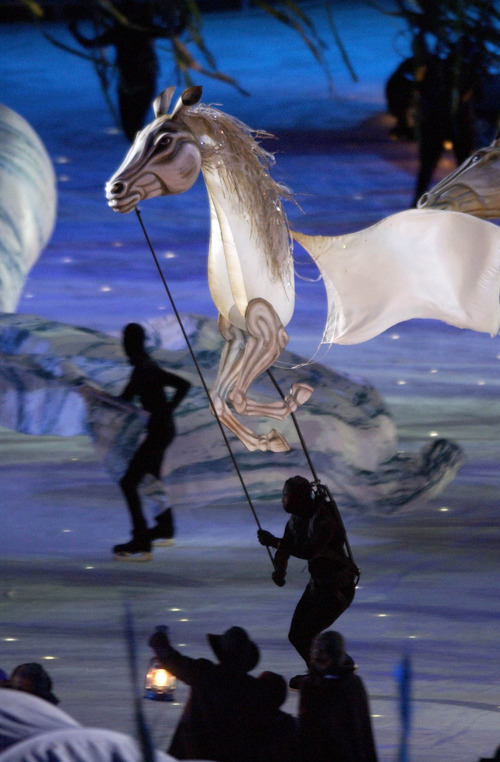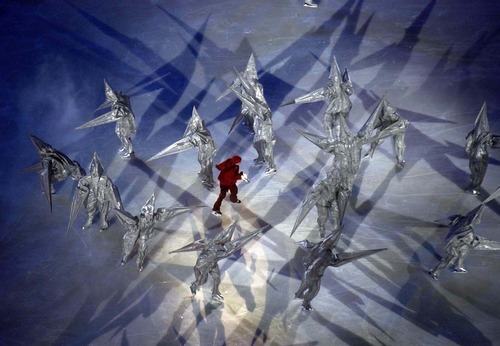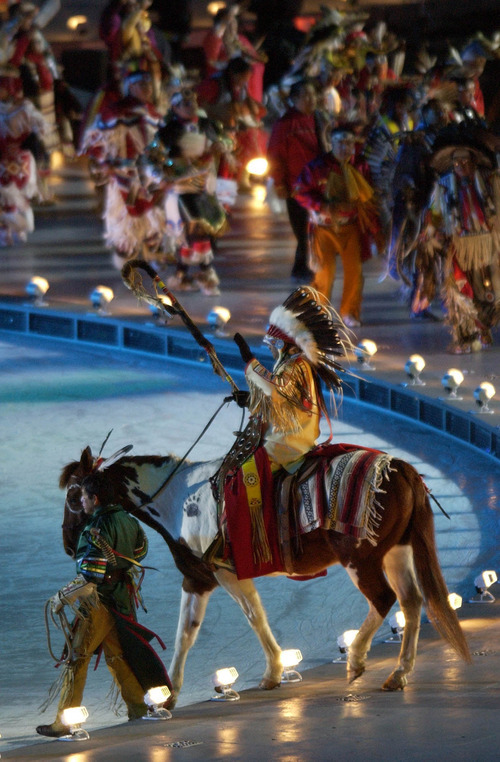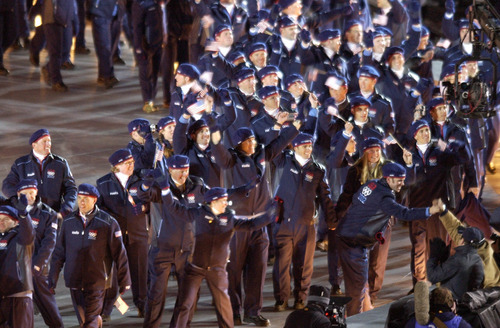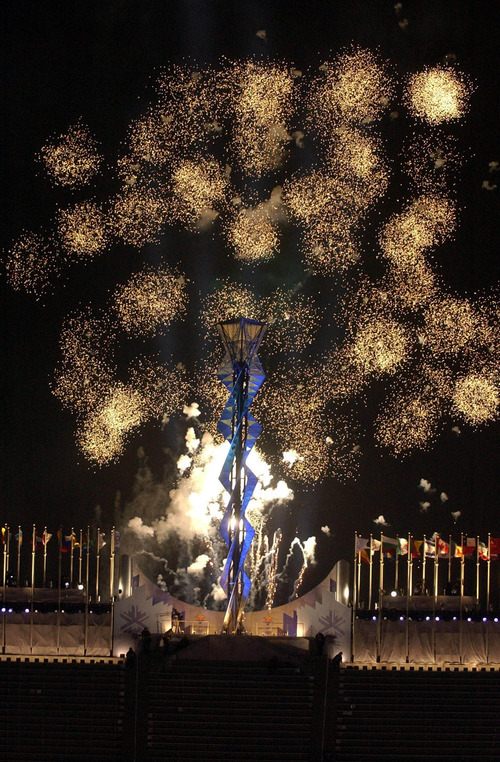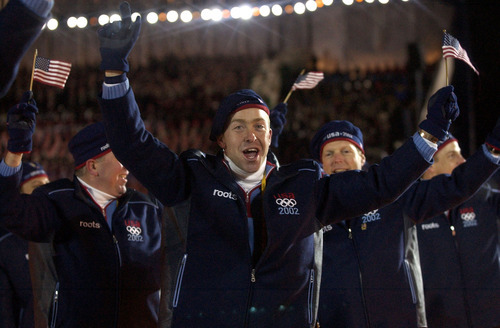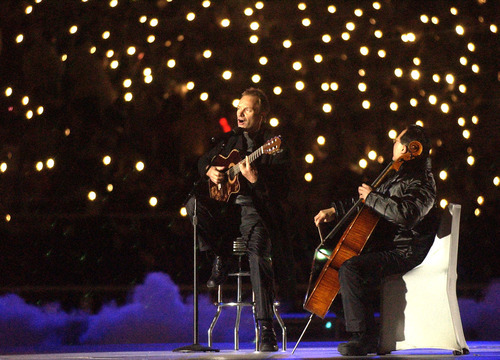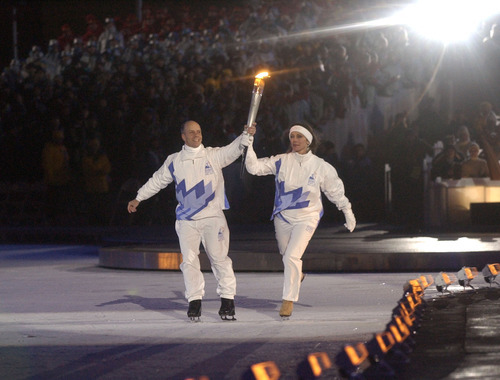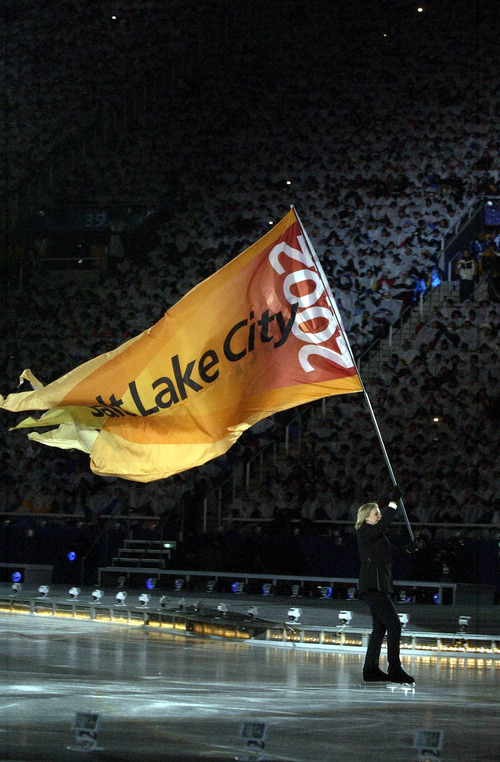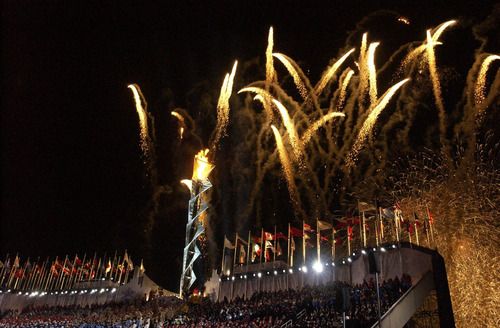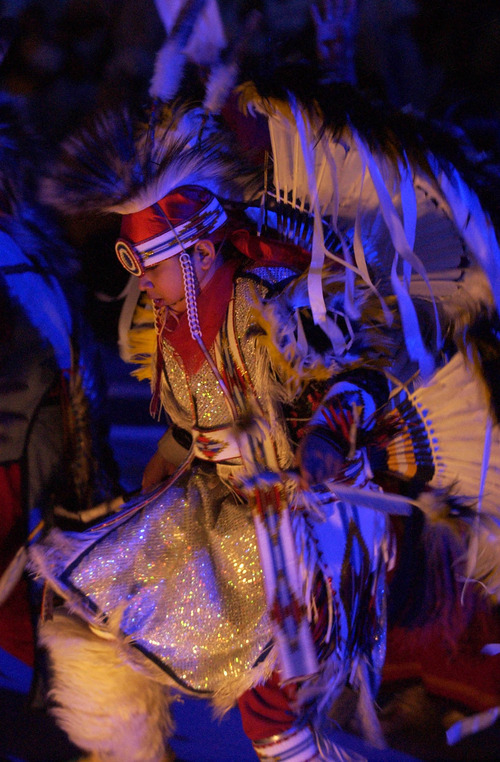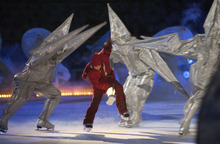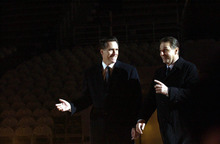This is an archived article that was published on sltrib.com in 2012, and information in the article may be outdated. It is provided only for personal research purposes and may not be reprinted.
Between angst about another terror attack and the cold, a sense of unease hung over representatives of Utah's American Indian tribes as they stood in a long security line 10 years ago Feb. 8, waiting for clearance to perform in the Opening Ceremony of Salt Lake City's Olympics.
Then Forrest Cuch looked into the sky west of Rice-Eccles Stadium and saw a golden eagle, symbol of good luck to Utah's native people, warming up for its role in the spectacle.
"I looked over to my son and told him, 'Let the people know,' " said Cuch, then director of the Utah Division of Indian Affairs. "All the Indian people settled down once they saw that eagle. Everything changed from fear to exhilaration and happiness."
Then, 10 minutes before their time on stage, the wind calmed. "Everyone looked at each other and said, 'Wow. It's like a message. Everything is going to be OK,' " Cuch said. "It was very surreal."
Those positive omens proved clairvoyant. The Opening Ceremony dazzled, initiating 17 days of Olympic action in which potential problems seemed to evaporate into Utah's thin mountain air.
The electric atmosphere at Opening Ceremony permeated to the depths of the University of Utah stadium, where volunteer Theresa Stauffer was helping other volunteers, painters and dry-wallers practiced in the art of walking on stilts, into costumes that would transform them into trees and crones for the show's historical segment.
"Just seeing a production of that magnitude being put together was fascinating," said Stauffer, a respiratory therapist at University Hospital.
And there were added benefits. The final leg of the torch relay came right past her staging area, as did the procession of athletes. "We were high-fiving the athletes and giving them candy we had stashed and trading pins with them," she said. "It was a lot of fun."
In the stands, viewers were mesmerized by the ceremony's mixture of Western history and its emotional references to the Sept. 11 tragedy and the Olympic movement's devotion to principles of fair play and mutual respect.
What a lineup of luminaries carried in the Olympic flag: South African civil-rights leader Desmond Tutu, Polish strike leader Lech Walesa, American astronaut-turned-senator John Glenn and Cathy Freeman, Aboriginal star of the Sydney Olympics. Joining them were filmmaker Steven Spielberg, environmentalist Jean-Michel Costeau and Olympic stars Jean-Claude Killy and Kazuyoshi Funaki.
Jaime Rupert, a public relations consultant for the Salt Lake Organizing Committee, had helped develop the idea of incorporating these distinguished global figures into the ceremony. She had pursued that task through the death of her mother the previous summer. As she stood alone in a camera platform at the stadium and watched the flag's entry, "I cried the whole way through," Rupert recalled. "I was saying to my mom [in heaven], 'Even though I had to leave you to do this, it was all worth it.' "
Even more poignant for most observers was the arrival of a tattered U.S. flag recovered from the rubble of the World Trade Center.
"That was such a powerful moment in my life," said hockey player Angela Ruggiero, one of eight American athletes selected as a flag bearer by her teammates. "I was walking on behalf of one of my USA teammates, Kathleen Kauth, who had lost her father on 9/11. To just walk into the stadium, dead silent in respect, with the president [George W. Bush] there and the whole IOC family … it was powerful and meaningful and just one of those moments."
And it had a moment of its own, one that brought tears to the eyes of Lane Beattie, then the state Olympic coordinator for Gov. Mike Leavitt.
"There was a flow of air that somehow got under and lifted that flag up," he recalled. "That was not orchestrated. It just happened. It was one of the most patriotic, humbling things I have ever experienced."
For Fred Ball, a leading figure in Salt Lake City's initial foray into the Olympic bidding in the mid-1960s, "it was probably one of the most exciting nights of my life. Coming so close to 9/11, it was so emotional, knowing the Games were going on regardless. I just thought the whole evening was magical, superbly done."
The ceremony culminated with the lighting of the caldron by captain Mike Eruzione and almost all of his teammates from the "Miracle on Ice" hockey team that surprisingly won gold at the 1980 Lake Placid Olympics.
SLOC President Mitt Romney was ecstatic that organizers had managed to maintain the secret that so many members of that legendary squad would participate in the lighting. But the climactic moment was a scary one as well for Romney, who had seen Sydney's caldron malfunction at the start of the 2000 Summer Games.
"The flame traveled slowly up the 117-foot base toward the glass bowl at the top. Gas was being fed to jets along the way. The flow was engineered to grow as the flame neared the top, but, instead, the flame was growing smaller as it ascended. Strong gusts of wind were dispersing the gas faster than it could fuel the flame," he wrote later. "Was it going out entirely? I didn't breathe. There were a few gasps from around me. And then, flash, the whole caldron bowl was swirling with flame, now shooting 25 feet into the air. Glorious, glorious, glorious!"
The jubilation of that moment reverberated throughout Utah.
In the Emery County town of Huntington, 150 miles away, Gayle McDonald watched the ceremony unfold on television, like most Utahns.
"Before the Olympics, I too was concerned about whether we would pull off a success," she said. "When the Opening Ceremony started, all fears ended. Success? Hell, yes."
Invigorated by that rousing beginning, Utahns fully embraced the Games.
People like Kenny Louie, a draftsman from Sandy, noted that he "barely got much sleep, getting up early to attend events and then running downtown in the evening just to be part of the action."
Students at the elementary school where McDonald works participated in drawings to attend Nordic skiing or biathlon events at Soldier Hollow. "Those who were chosen felt it a special privilege," she said, adding that she and her husband were compelled to drive to Salt Lake City to see the scene for themselves.
"It was beautiful," McDonald said. "The atmosphere, the weather, the pictures on the buildings, I don't think it could have gone better. I was more proud of our state than ever before."
For Olympic connoisseur Everen Brown, who will attend his 12th Games this summer in London, the civic jubilation triggered by the 2002 Opening Ceremony helped his friends better understand his obsession.
"Early on, it was really hard trying to communicate to people the importance and fun of the Games coming to Salt Lake," he said. "People would question me: 'Why do you fly around the world, stand in lines, get tickets, find hotels, go through all that work?' But once they saw what it was like when the Olympics came to Salt Lake, it all fell into place. They knew why."
As many Utahns now do.
Twitter:@sltrib.com —
Setting the stage
"In terms of world audience, the Opening Ceremony is the biggest moment by far. Viewership cuts across both genders, all ages, all cultures, all demographic groups. Our Opening Ceremony broadcast would be seen in 160 countries by over 2.1 billion people, the largest televised audience in Olympic Winter Games history." — Mitt Romney, in Turnaround — Crisis, Leadership and the Olympic Games —
Light the fire again
To mark the 10th anniversary of the Salt Lake Games, the Olympic caldron will be re-lit briefly in a ceremony beginning at 6:30 p.m. Wednesday. The ceremony will be broadcast live on television, but anybody who wants to attend the event is welcome, said event organizer Colin Hilton. Parking is limited, however, in the lot west of the University of Utah's Rice-Eccles Stadium. Olympic and Paralympic athletes, mascot figures and local dignitaries are expected to attend.


